Announcement: My online Land Navigation course includes four hours of video instruction, and two downloadable PDF books, all for about the same price as a typical paperback book. Get my Land Navigation course here.
The Monthly Lunar Cycle
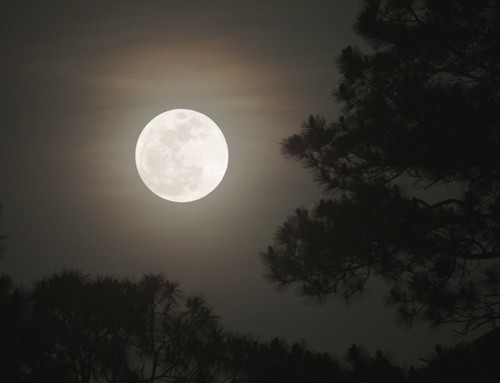
Besides Being Beautiful, the Moon Can Help You Find Your Way
Note From Me
Before you can fully understand how to get directions from the moon, you must first understand how the moon works. The purpose of this page is to help you do just that. The next time you see the moon, my goal with this page is for you to better understand the hows and whys of waxing and waning, and for you to have a working knowledge of the moon's travels through our skies.
Reid
The moon--located about 240 thousand miles from earth--completes its lunar cycle about once a month. In other words, it orbits the earth approximately once each 30 days. At all times throughout its orbit, half of the moon is ALWAYS lit by our gigantic sun, located some 93 million miles away. How much of the moon's sunlit half we see here on earth depends on the moon's changing position in relation to the sun and the earth.
New Moon
When the moon is directly between the earth and the sun, we don't see any part of the sunlit half, meaning the moon is not visible to us.
As the moon begins its monthly orbit around the earth, we begin to see a tiny but waxing (growing larger) sliver of a new moon in the western sky just after sunset.
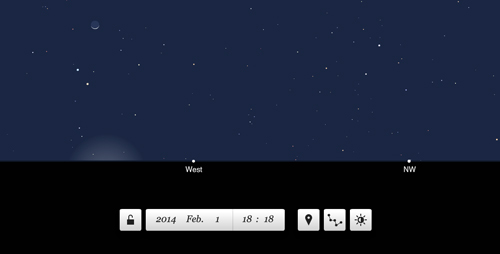
New Moon As Seen Just After Sunset
Courtesy of Neave Planetarium
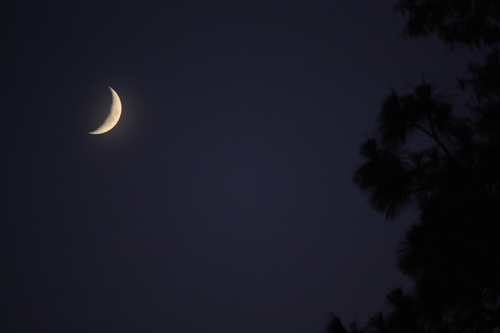
Northern Hemisphere: A Waxing Moon - Notice that the Right Side is Lit.
With a Waning Moon, the Left Side is Lit.
Southern Hemisphere: The Left Side of a Waxing Moon is Lit. The Right Side of a Waning Moon is Lit.
First-Quarter Moon
As the moon continues its orbit eastward around the earth, it slips ever farther away from the sun each day, exposing more and more of its sunlit half. Over about a week, the new moon waxes from a thin sliver into a solid half moon shape. This half moon is also called a "first-quarter moon" because the moon, now 90 degrees away from the sun, has completed one-quarter of its monthly earthly orbit.
Full Moon
The first-quarter moon continues to move each day farther from the sun, waxing fuller until it has reached the point in its orbit when it is on the far side of the earth from the sun. At this point, we see the entire sunlit half of the lunar sphere, that is, we see a full moon.
It seems to be a common misconception that the earth would block the sun's light to the moon if the moon were on the opposite side of the earth from the sun. While this happens occasionally--it's called an eclipse--normally the sun's light to the moon is not blocked at all, but instead lights up an entire half of it. That lit half we call a "full moon."
Last Quarter Moon
As the lunar cycle continues, the full moon continues its eastward drift through the skies, but past the full moon, rather than moving away from the sun, the moon now moves closer to the sun with each passing day.
The moon, which was once full, wanes (grows ever smaller) until it once again becomes a "half moon," which is really a "last-quarter" moon, meaning the moon has completed three-quarters of its monthly earthly orbit.
Old Moon
With the passage of days, the moon wanes into a thin sliver of an "old moon," appearing in the eastern sky just before sunrise. Finally, the moon disappears from view once more, only to begin the cycle anew.
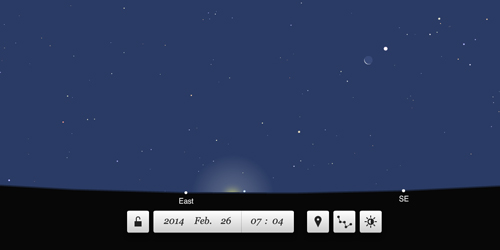
Old Moon Seen Just Before Sunrise
Courtesy of Neave Planetarium
Helpful Tip
A waxing moon "trails" the sun across the sky. Remember, the moon drifts eastward through the stars each day, so if the moon is east of the sun (i.e. trailing it), it's getting farther away from the sun, and its lit half becomes continuously more exposed to us.
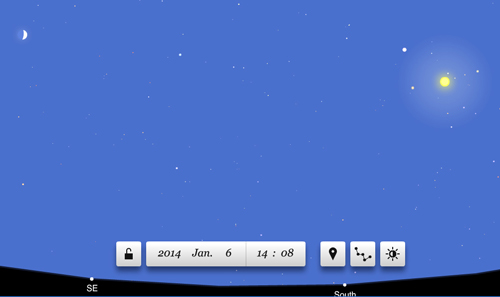
Here the Waxing Moon Trails the Sun Across the Sky
Courtesy of Neave Planetarium
If the moon is west of the sun (i.e. "leading it"), it's moving closer to the sun, and is therefore waning.
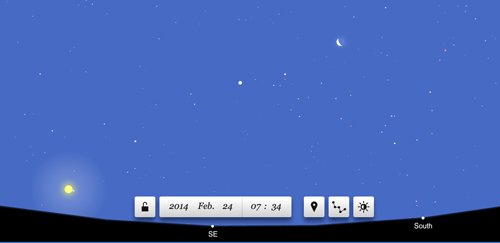
Here the Waning Moon Leads the Sun Across the Sky
Courtesy of Neave Planetarim
Return from Lunar Cycle to Celestial Navigation
Return from Lunar Cycle to Home

